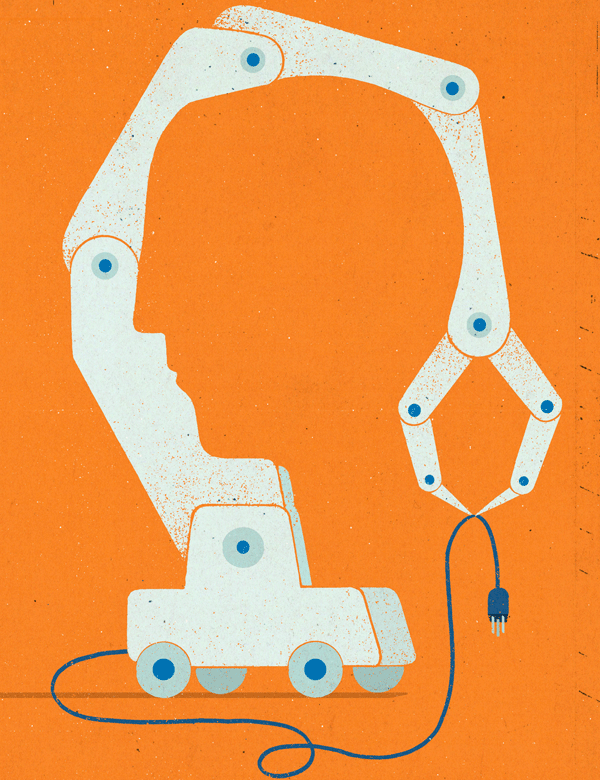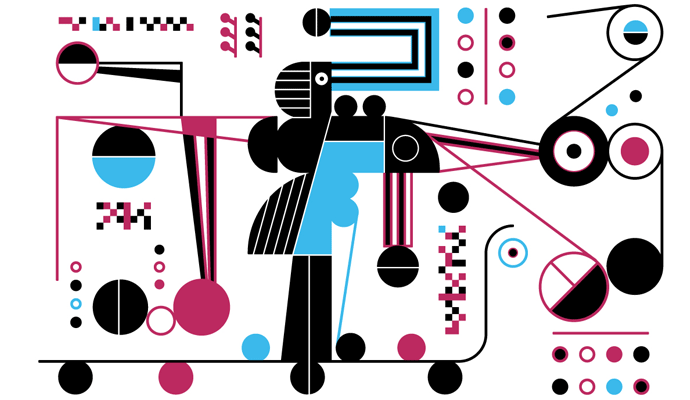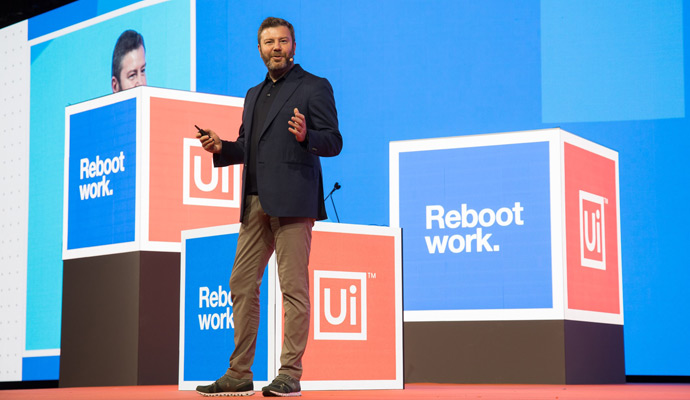Slow-motion automation
History shows that new technologies evolve faster than society adopts them.
A version of this article appeared in the Winter 2016 issue of strategy+business.
Automation — in the form of machine learning, robotics, autonomous vehicles, white-collar bots, exoskeletons, and so on — is changing the nature of work in a wide range of industries. In conducting research for my new book, Silicon Collar: An Optimistic Perspective on Humans, Machines, and Jobs (Deal Architect, 2016), I examined people at work in more than 50 settings: accounting firms and banks, the battlefront and digital agencies, the oil patch and restaurants, R&D labs and shop floors, warehouses and wineries. And it is clear that the old divisions among professions and trades have dissolved. We’re no longer white- or blue-collar workers. We’re all silicon-collar workers, because technology is reshaping all our workplaces.
Broadly speaking, this is a positive development for workers. Technology makes them safer, smarter, and faster. Aided by telematics, UPS drivers on average get into less than one accident per million miles driven. In China, Foxconn employees working alongside bots and precision equipment have delivered billions of high-quality electronic devices to Apple and other customers.
Yet although most workers I encountered expressed positive sentiments about the new technologies, many prominent academics, analysts, and economists are worried sick about the new machine age. Two Oxford University researchers, Carl Benedikt Frey and Michael A. Osborne, concluded “about 47 percent of total U.S. employment is at risk” due to automation. At the 2014 Gartner Symposium/ITxpo, Gartner projected “one in three jobs will be converted to software, robots, and smart machines by 2025.” As politicians amplify the fears that robots will soon steal all our jobs, the sense of gloom is palpable. And radical new societal solutions are being considered. Switzerland held a referendum in 2016 on whether citizens should be guaranteed minimum incomes, irrespective of work status, partially in anticipation of future job loss. (It failed.)
But there’s a case to be made that these fears are misplaced. A look back at how disruptive technologies have made their way into common use suggests that automation can take its own sweet time in displacing human labor. Research on the history of UPC codes and scanners since 1948; the ways in which cars have gradually been taking over control of driving from humans since cruise control was first introduced by Chrysler in 1958; and more recent case studies on artificial intelligence, robotics, self-service, and many other technologies and their related impact on jobs have led to what may seem to be a counterintuitive conclusion. Automation does affect many “3D tasks” — dull, dirty, and dangerous work that most humans are ultimately glad to give up. But societies absorb automation at a pace that’s much slower than technology’s evolution. And five powerful “circuit breakers” help delay and influence the trajectory of automation in surprising ways.
Technology hype cycles. Automation never rolls out as quickly as people expect because of the human tendency to get overexcited and excessively optimistic about the potential for shiny new products and to hype them up. We do this continuously, and never seem to learn.
In 1950, British mathematician Alan Turing designed a famous test to measure a machine's ability to exhibit intelligent behavior equivalent to that of a human. In 1959, technologists exulted when Allen Newell and his colleagues coded the General Problem Solver. In 1968, Stanley Kubrick sent our minds into overdrive with HAL, the computer with a mind of its own, in 2001: A Space Odyssey. We applauded when IBM’s Deep Blue supercomputer beat grandmaster Garry Kasparov at chess in 1997. And again in 2011 when IBM’s Watson beat human champions at Jeopardy. Now, as household devices like Amazon’s Echo digital assistant/home automation hub can recognize the human voice, enthusiasts are arguing that a machine has finally passed the Turing Test. It took only 70 years! And we’re still not quite there. As Yann LeCun, director of AI research at Facebook, puts it: “Despite these astonishing advances, we are a long way from machines that are as intelligent as humans — or even rats. So far, we’ve seen only 5 percent of what AI can do.”
Slow customer adoption curves. Appearances to the contrary, customers — whether they are businesses or consumers — are often slow to adopt new automation technologies. 3M, one of the most innovative companies in the world, manufactures more than 55,000 products and keeps a close eye on its new product introductions. It created a metric it calls the new product vitality index (NPVI) to measure the percentage of sales coming from products launched in the previous five years. In 2015, 3M reported that its NPVI was 33.3 percent. Bear in mind that many would not consider a product launched five years ago to be new. Even so, for the average company, customer adoption of new products is considerably slower.
Luther Simjian, a prolific inventor, convinced some New York City banks to try out his Bankograph, the predecessor of the modern-day ATM, in 1960. Almost six decades later, although mobile banking has taken off and ATMs are ubiquitous, our downtowns and strip malls are still studded with bank branches staffed by human tellers. The Bureau of Labor Statistics estimated the U.S. still had 520,000 teller jobs in 2014, and a gradual decline of only 40,000 positions is projected over the next decade. Put another way, virtually every bank customer has the ability and means to conduct automated banking business, but tens of millions still choose to do so in person.
The Bureau of Labor Statistics estimated the U.S. still had 520,000 bank teller jobs in 2014.
There’s more. With digital voice mailboxes, word processing, and smartphones, who needs secretaries or administrative assistants? According to the Bureau of Labor Statistics, that category still employs nearly 4 million workers in the United States. And although millions swear by online travel sites, more than 40 percent of travel reservations are not made on the Internet. Travel agents may be an endangered species, but thanks to slow customer adoption, they are far from extinct.
Incumbents fight back. The third “circuit breaker” delaying automation is the effort of incumbents. Many technologists conclude that because new automated processes or products work well, they will immediately be adopted. But this line of thinking overlooks a source of significant friction: incumbents. Autonomous vehicles may seem to be an inevitability. But powerful incumbent interests will adapt and continue to market the benefits of driven cars. These incumbents include the auto insurance industry (with sales of US$200 billion annually in the U.S.), the auto aftermarket industry ($300 billion annually in the U.S.), and the parking industry ($100 billion annually in the U.S.), which is not too thrilled about autonomous cars that could move continuously and not need a space to stop for hours. And treasurers in most cities and counties do not want to miss out on revenues from speeding tickets. So as manufacturers develop autonomous vehicles, these large organizations will craft new regulations, lobby for new laws, and try to stop those revenue streams from drying up. Auto insurance companies, for example, are already arguing against offering lower premiums today because although cars with safety sensors and other sophisticated technologies are less likely to be in an accident, repairing them costs more than repairing yesterday’s vehicles. Product liability issues involving driverless cars will greatly complicate today’s subrogation process of assigning blame and liability for collisions. The biggest incumbent resistance will likely come from drivers themselves. Indeed, Mazda is counting on drivers’ continued love for what it has branded “Zoom-Zoom.” Along with Porsche and a few other carmakers, it has shown little interest in making driverless cars.
Tacit knowledge. It’s tough to automate what you cannot specify. And despite all the progress we’ve made in process management and human resources, a great deal of the vital knowledge that workers possess is tacit. The Hungarian–British polymath Michael Polanyi explained it succinctly: “We can know more than we can tell.” Many knowledge management professionals use the metaphor of an iceberg. The visible area represents explicit knowledge, which is relatively easy to codify and potentially automate; the much deeper, under-the-waterline portion represents the tacit material workers know but cannot effectively “tell.”
A fascinating example of tacit knowledge can be seen in the daily work of the 5,000 “dabbawallas” in Mumbai, India. These couriers pick up food in lunch boxes (dabbas) from the homes of customers and deliver them by train, bicycle, and cart to offices, so the spouse (or other recipient) can enjoy a hot meal. They then reverse the process, delivering the 200,000 boxes back home. Even though they use little technology, and even though Mumbai is known for its chaotic traffic and lack of street names and addresses, the dabbawallas have a remarkable, Six Sigma–level track record — they are estimated to miss only one delivery in every 6 million.
Their success has attracted a series of potential disrupters. Several hundred food delivery apps have appeared in India over the past few years, and have raised hundreds of millions of dollars in capital. But none have dented the dabbawalla model because the apps cannot duplicate the tacit knowledge that the dabbawallas have accumulated and deployed to great effect.
Unintended consequences. The fifth and final “circuit breaker” that can delay automation is the most unpredictable. Economic history is rife with examples of inventions that have significant ripples and unintended consequences. Paradoxically, automation can actually lead to more human work in the fields in which it might have been expected to obliterate it. The introduction of UPC codes in many stores starting in the mid-1970s led to improved inventory control and increased store sales. Grocery checkout jobs thus increased. Email and e-commerce may have reduced the demand for the delivery of letters, but they have not killed off the U.S. Postal Service. In fact, e-commerce has created an entirely new category of postal jobs related to delivering items ordered online. The robots at the mail marketing company Valpak and those at the distribution centers of Amazon and other companies help keep more than 600,000 postal employees busy.
By the same token, lots of people will be needed to manufacture, operate, and repair today’s robots and drones; code the machine learning algorithms; and update the infrastructure needed to communicate with autonomous vehicles.
The presence of these five circuit breakers should not lead us to minimize the dangers and challenges automation poses to contemporary work and social arrangements. Millions of people will, in fact, find their jobs transformed by machines and robots in the coming years. But in the short term, we should be far more worried about the threats posed to our labor economy by millions of unfilled jobs, massive student debt haunting younger workers, and an inadequate education system. We should spend more time embracing machines as colleagues and less time worrying about jobless societies. Thanks to the powerful and enduring circuit breakers, even in an age in which technology moves at warp speed, we will have plenty of time to absorb automation gradually.
Reprint No. 16402
Author profile:
-
Vinnie Mirchandani was formerly Gartner and PwC executive and is CEO of Deal Architect, a technology advisory firm. He writes about technology-driven business innovation at his blog, New Florence. New Renaissance. Silicon Collar is his sixth book.




